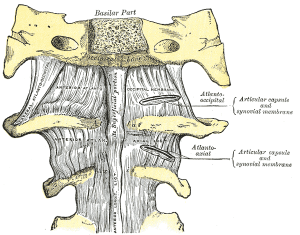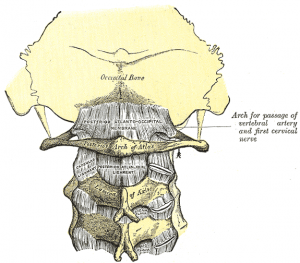Atlanto-occipital joint
Original Editor - Rachael Lowe
Lead Editors
Description[edit | edit source]
The atlanto-occipital articulations function as bilaterally symmetrical ellipsoid synovial joints between C0 and C1.
Articulating Surfaces[edit | edit source]
Occipital condyles and a superior articular facets of the atlas.
Ligaments & Joint Capsule
[edit | edit source]
The capsule is rather roomy and relaxed and the joint possesses no individual accessory ligaments. Stability is provided by:
- Two articular capsules
- Posterior atlanto-occipital ligament
- Anterior atlanto-occipital ligament
Muscles[edit | edit source]
Motions Available[edit | edit source]
The movements permitted in this joint are movements of the head on neck, consisting of:
- flexion and extension around the mediolateral axis, which give rise to the ordinary forward and backward nodding of the head (15° to 20°)
- slight lateral motion, lateroflexion, to one or other side around the anteroposterior axis (10°).
Flexion is produced mainly by the action of the rectus capitis anterior. Limited by tectoral membrane.
Extension by the rectus capitis posterior major and minor, assisted by the obliqus capitis superior, the semispinalis capitis, splenius capitis, sternocleidomastoid, and upper fibers of the trapezius.
The rectus capitis lateralis are concerned in the lateral flexion, assisted by the trapezius, splenius capitis, semispinalis capitis, and the sternocleidomastoid of the same side, all acting together.
Closed Packed Position[edit | edit source]
Open Packed Position[edit | edit source]
Pathology
[edit | edit source]
Resources[edit | edit source]
Recent Related Research (from Pubmed)[edit | edit source]
Failed to load RSS feed from http://www.ncbi.nlm.nih.gov/entrez/eutils/erss.cgi?rss_guid=1BYJ_3OKYOAie6qzLUkBFBTQb8vJe0E5gFImvJ_yxW6lYkmweX|charset=UTF-8|short|max=10: Error parsing XML for RSS
References[edit | edit source]
References will automatically be added here, see adding references tutorial.








